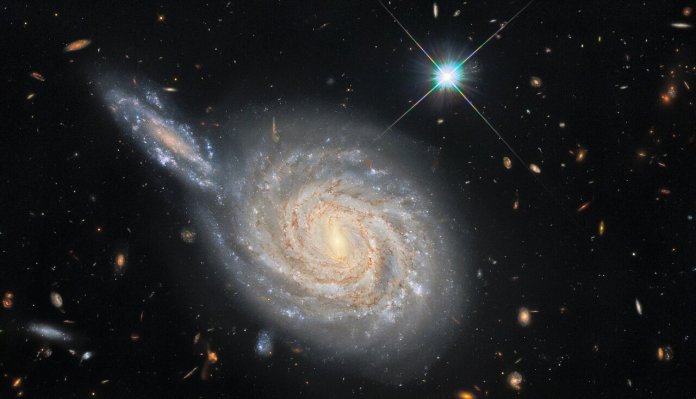This spectacular image from the NASA/ESA Hubble Space Telescope captures the spiral galaxy NGC 105, which lies roughly 215 million light-years away in the constellation Pisces. While it looks like NGC 105 is plunging edge-on into a neighboring galaxy, this is just a circumstance of perspective. NGC 105’s elongated neighbor is actually far more distant. Such visual associations are the result of our Earthly perspective and they occur frequently in astronomy. A good example of this are the constellations. The stars that form constellations are at vastly different distances from Earth. To us they appear to form these patterns because they are aligned along the same sightline, while an observer in another part of the galaxy would see different patterns.
Hubble’s Wide Field Camera 3 observations in this image are from a vast collection of Hubble measurements examining nearby galaxies that contain two fascinating astronomical phenomena—Cepheid variable stars and cataclysmic supernova explosions. While these two phenomena may appear unrelated—one is a peculiar class of pulsating stars and the other is the explosion caused by the catastrophic death of a massive star—astronomers use both to measure the vast distances to astronomical objects. Both Cepheids and supernovae have very predictable luminosities. Astronomers use these so-called “standard candles” to determine distances by comparing how bright these objects appear from Earth to their actual brightness. NGC 105 contains both supernovae and Cepheid variables, giving astronomers the opportunity to calibrate the two distance measurement techniques against one another.
Astronomers recently analyzed the distances to a sample of galaxies including NGC 105 and their velocities to measure how fast the universe is expanding—a value known as the Hubble constant. Their results don’t agree with predictions made by the most widely accepted cosmological model, and their analysis shows that there is only a 1-in-a-million chance that this discrepancy is the result of measurement errors. The difference between galaxy measurements and cosmological predictions is a long-standing source of consternation for astronomers, and these recent findings provide credible new evidence that something is either wrong or lacking in our standard model of cosmology.
– Advertisement –
